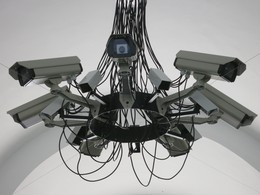Mirko Tobias Schäfer / Assistant Professor
University of Utrecht Department for Media and Culture Studies
Mirko Tobias Schäfer / Assistant Professor
University of Utrecht Department for Media and Culture Studies
Practices of hiding faces and disguising ones identity has emerged as a media practise in a world where anonymity was difficult to upheld and where anonymity became challenged through all kinds of requirements. Doringer argues that these media practices also manifest in art. Part 1 of the two-part exhibition presents works that play with the invisibility, hidden identity, strategies of disguise and exposure; part 2 will revolve explicitly around the political impact and social consequences.
Asymmetric Love Nr. 2 by Addie Wagenknecht and Stefan Hechenberger playfully re-uses CCTV equipment which is so pervasively present in our everyday urban life. A number of surveillance camera's are arranged to a 'baroque' chandelier and placed as such in an entrance portal of the Museumsquartier. The serviceable design of the aesthetically unpleasing camera's is all of a sudden turned into an integral component of an aesthetic artefact. Stripped of their original functionality the now defunct camera's serve as a reminder for asymmetric relationship between observer and subject, between recording device and citizen. In accordance with the exhibition theme, Wagenknecht and Hechenberger distributed 500 black glasses in shape of the censor bar, known from anonymized persons in press photography.
A fictional view behind the front-end of surveillance has been provided by Max Gurresch and Matthias Tarasiewicz (both ATechRes) with their work Documenting Surveillance. Planned as the counter piece to Wagenknecht's and Hechenberger's surveillance chandelier Gurresch and Tarasiewicz were playfully re-enacting the working environment of those professional watchers. Their installation shows a probably hastily deserted room: Monitors, maps, computers, manuals, a desk and chair cramped into a small office space invite to make up the characters who might have been working here on a surveillance project. They write:
“Surveillance work can be challenging - according to the U.S. Department of Labor it includes stress, danger, confrontations with angry or upset individuals, physical discomfort, lethal hazards, fieldwork in high crime areas, monotony, constant alertness to threatening situations, irregular hours, and a heavy toll on private life, among other risks [...] Who are those people and employees observing us in all possible situations of our lives?"
Tarasiewicz and Gurresch argue that the persons who actually watch us defy our attention. However, their humanity constitutes a crucial weakness of the surveillance apparatus.
There are only few examples in media culture where those who do the work of watching others come into the spotlight. Usually they remain anonymous and invisible. Often we do forget that there are human beings at the other end of the surveillance technology. Gerd Wieser, the Stasi officer assigned to spy on a playwright author in Florian von Henckel Donnersmark's famous film The Life of Others (Das Leben der Anderen) is one of the few examples where the other side of the asymmetric relation between subject and observer comes to live for a broader audience. Whistle-blowers, such as William Binney and most prominently Edward Snowden are real-life examples where the faceless apparatus of state surveillance all of a sudden gets a human face and a human touch. Troubled by the perpetual violation of civic rights the former collaborators of the system now turn to society to warn about the slippery slope to totalitarianism. Recognizing the human operators behind the technology that disguises the watchers while recording the private lives of others, should remind us of those people who actually design, feed and operate the apparatus of production. Responsible are our political leaders and their voters who in a jerk-knee reaction consider automatized and computer-aided massive surveillance as appropriate answer to vague and often unfounded threats.

The recent disclosures of the US American spy program PRISM and its British version Tempora have put the issue of surveillance on the public agenda again. In 1998, the debate revolving around the Enfopol papers had pointed the public interest to surveillance activities of authorities. With the exhibition Ctrl Space in 2001, Thomas Y. Levin provided an overview of the rhetoric of surveillance and the multiple ways artists react to the media practices of observation and privacy invasion (Levin, Frohner, Weibel 2002). The newly revived public interest in state surveillance appeared at a time, when curator and artist Bogomir Doringer was putting together the Faceless show in Vienna's Museumsquartier.